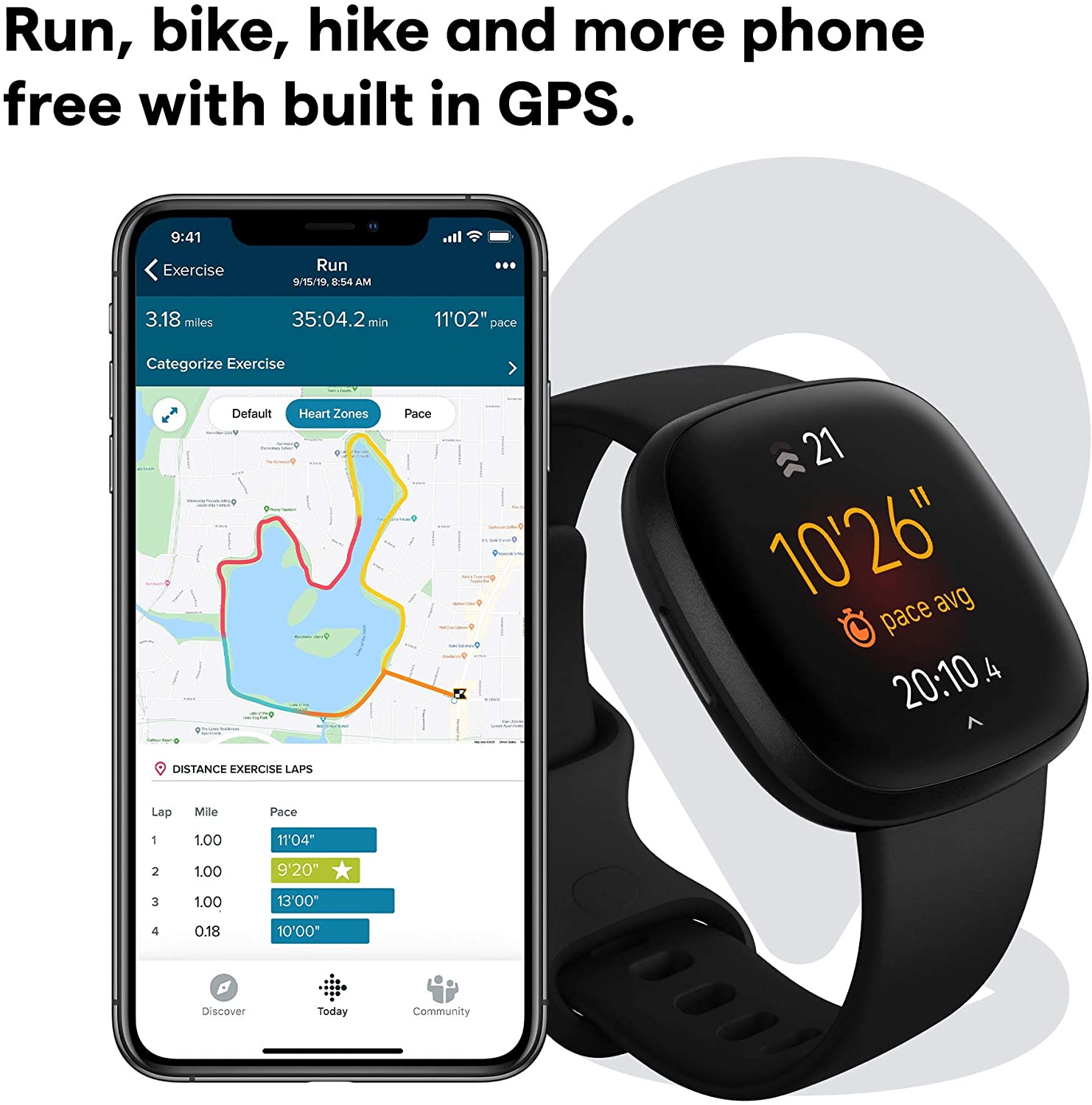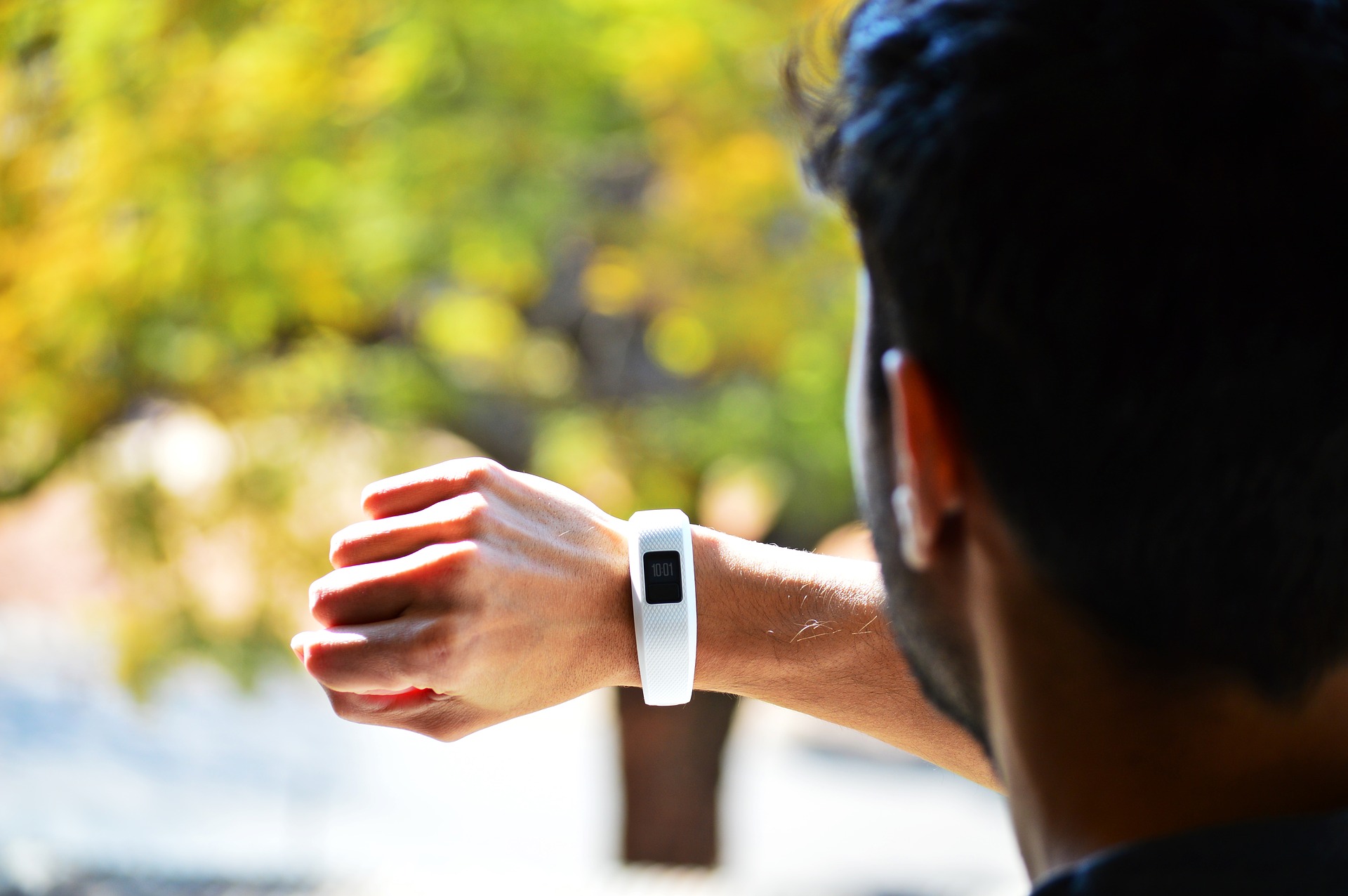
With the Fitbit Versa 3, the manufacturer from San Francisco ushered in the third generation of its very successful smartwatch in August 2020. The smart watch, which is once again aimed at men and women in different versions, has received a number of innovations. For the first time, it is given a GPS module, which can be used to record activities in the open air without the support of the smartphone. In addition to the already familiar Amazon Alexa, the Google Assistant also makes its way onto the wearable as a second intelligent assistant.
Another innovation is the fast charging mode, where the watch refuels energy for a whole day within twelve minutes. Apart from that, it combines the already familiar capabilities of its predecessors. It supports a variety of sports, offers precise heart rate measurement as well as detailed sleep tracking, while women can also log their periods.
In this article
Scope of delivery, design, setup
The scope of delivery includes all the necessities. In addition to the actual Versa 3, there is a silicone wristband in two lengths as well as a charging dock. This hangs magnetically on the back of the watch. The wristbands can be detached with a flick of the wrist and replaced with other options. Unfortunately, Fitbit has changed the clasp compared to the predecessor. Where a metal pin used to sit, there is now a click mechanism, meaning older wristbands are not compatible.
Too bad, we liked the metal wristband on the Versa 2. However, we would advise buyers to use a different wristband in any case. The included silicone wristband is not very breathable and is also difficult to close with its two loops. A dedicated sports wristband from Fitbit or one with leather or metal is better. For example, we ordered a cheap metal wristband with a magnetic clasp from Amazon, which could be clipped onto the watch without any problems.
There is again little to complain about in terms of design. The square screen is a bit thick, but it is not too bulky thanks to its rounded corners. Fitbit uses an OLED display and likes it well. The content, especially when it contrasts strongly with the black background, looks great. Even in strong light, you can see the information well. All in all, a successful design, in our opinion, perhaps a bit bulkier than the Sense. However, the Versa 3 is smaller in return.
Technical Details
| Size screen | 1,6 inch |
| Wrist band material | synthetic |
| Size watch | 40,48 x 40,48 mm |
| Connectivity | Bluetooth 5.0 |
| GPS | Yes |
| Battery life | 6+ days |
| Supported systems | Android, iOS, Google, Amazon Alexa |
| Water resistance | No |
| Display | AMOLED |
| Sensors | PurePulse 2.0, SpO2, GLONASS |

Apps
There are no exclusive features in the app compared to other Fitbit devices. The data from the watch flows into the Fitbit app and is processed there in a sensible and clear manner. We have always liked the Fitbit app, and we like it again this time. Our highlight is the tracking of the different sleep zones, where the Versa 3 scores again. We also recommend that everyone download the watch face with the oxygen saturation measurement from the app’s integrated store.
This data, along with respiration rate, heart rate variability, skin temperature and resting heart rate, flows into the new “Health Values” section. The current week’s data is shown there, and those who sign up for a premium subscription get a 30-day view. The premium subscription unlocks even more functions, such as coaching. We will discuss Fitbit Premium in detail in our review of the Sense.
Activity and sports
The Versa 3’s main discipline is still as a fitness companion in everyday life. First and foremost, the device tracks movement, including steps, activity zones, floors and the total distance covered. This works very well, with one exception of floors – this value is far from reality.
It is a bit of a shame that you can only enter the water consumption in a very complicated way. You first have to swipe up, find the settings and activate the widget. Then swipe up again, find the water setting, go to “Add” and then you can enter how much you have just drunk. Why hasn’t this long been a freely assignable icon that adds 250 ml of water with one press, for example?
When it comes to sports, it looks good. Thanks to GPS, the Fitbit Versa 3 is a solid companion and can independently record the distance traveled. This is the first Versa with built-in GPS and it’s a handy addition to the tracker, even if it does negatively impact battery life. As always, Fitbit comes with a number of workout programs that you should start before your session. Besides running, swimming or cycling, this also includes units like workouts or yoga.
The Versa 3 records the distance, as far as that makes sense. However, the heart rate measurement is probably more important, so you can also see afterwards how much time you spent in which heart rate zones. All information flows back into the app, which makes it a great fitness smart watch.

Music
Where GPS is a practical new feature, unfortunately little has changed in terms of music. Spotify is advertised on the box, but it is only a remote control for Spotify Connect. In other words, you can control the music that is played from the smartphone or other devices. Yes, it works, but we hardly found any reasonable reasons to use the feature. Offline music is only possible via Deezer playlists, i.e. only for premium Deezer customers. It is a pity that Fitbit is not braver here and includes a decent music player for local songs or workout mixes.
Notification and payments
As always, the watch can be connected to the smartphone, and incoming messages or calls are then shown on the display. Thanks to a microphone and speakers, you can even make calls via the watch. This works okay, but the quality varies depending on the volume and type of ambient noise.
Like its predecessor, the Fitbit Versa 3 is a virtual credit card on demand. This works pleasantly easy in practice – as long as you use an account at a corresponding bank. In the test with Openbank, we were able to store our card without any problems. You then have to define a PIN. This can be used to activate the payment function. In practice, this works quickly and reliably; we successfully paid with the watch several times. By the way, Fitbit offers its own prepaid Visa card that can be topped up and used for Fitbit Pay.
Sleep and battery life
The sleep tracking is excellent. The watch is easy to wear at night and it neatly and comprehensibly measures the different sleep stages. With the excellent app to go with it, it’s easy to see which phases you’re going through and when. Fitbit also gives tips on when to go to bed, and a do-not-disturb mode is also included. The integrated alarm clock has a smart function that is supposed to wake the sleeper when he is about to wake up anyway. In the test, it convinced us so mediocre. We did not get up at the alarm, but rather lay back in bed with “ha, I still have 20 minutes until the alarm rings”.
The runtime of the Fitbit Versa 3 is about four to five days in reality with a few workouts, a bit less if you use the GPS excessively. Via the included charging adapter, the watch is full again in about an hour. However, thanks to a quick charge function, you can get over a day with just under 15 minutes of charging.

Price
The street price of the Fitbit Versa 3 is around 200 euros, which is less than the MSRP of Fitbit (just under 230 euros) or the Fitbit Sense (280 euros). Wristbands cost from 35 euros upwards, at least the official ones. There are numerous offers from third-party manufacturers on Amazon or other online shops, sometimes around 10 Euros. But then you should at least cross-read the reviews and make sure that you really get a wristband for the Versa 3 (or the Sense).
Conclusion
The Fitbit Versa 3 is a good activity tracker and a very usable sports watch for everyday use. Where is the difference to the Sense? Basically, only the functions around stress management and the ECG app are missing, otherwise the devices are almost functionally identical. So, if you can do without an ECG, you can also go for the cheaper Versa 3 and then have almost all features. It remains to be seen whether and how Fitbit will develop further after the takeover by Google.



